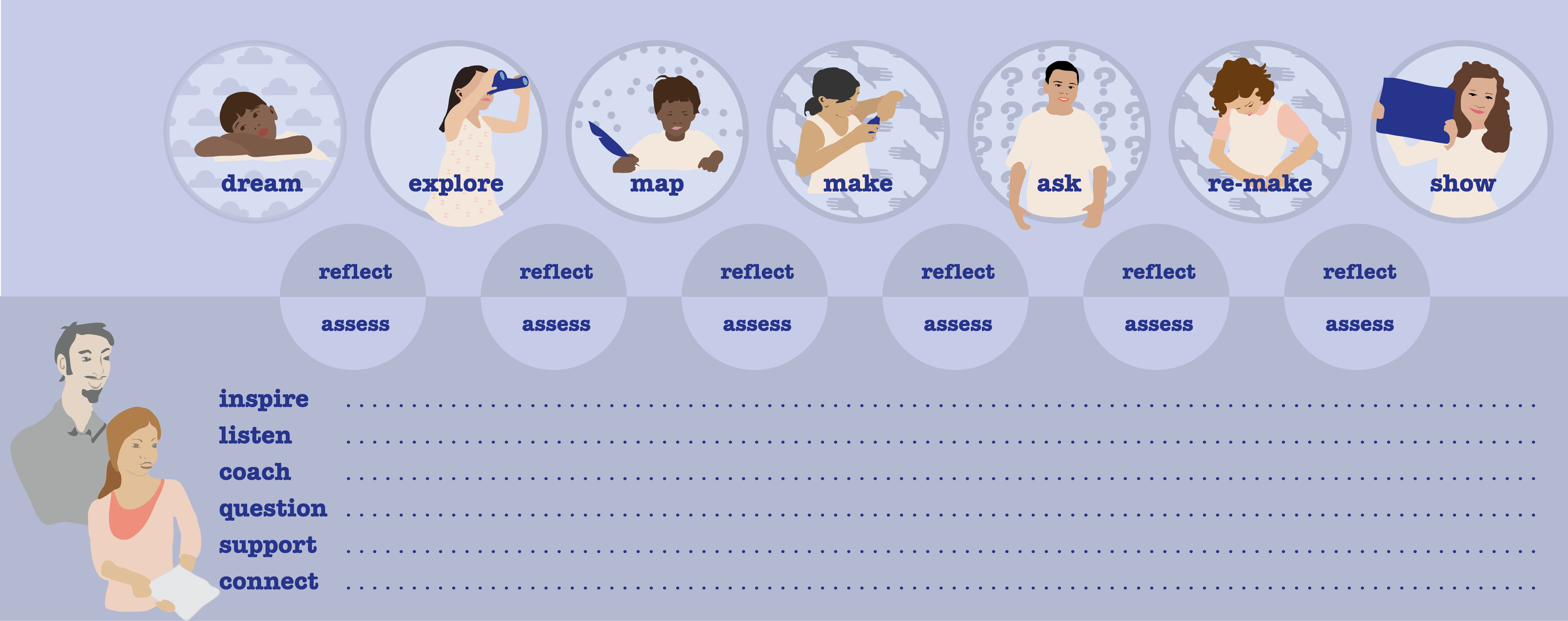This cycle Learning Stories and Activities focus on “real world” challenges, that is, challenges related to the sociocultural context of the students and are personally meaningful to them. Students work with realistic problems, selecting personally meaningful challenges or addressing the challenges of an audience they can relate to. To give future stories stronger stronger grounding in personal learning goals, please add your personal experiences as comments to the blog or as entries to the iTEC planning tool “Composer”.
The activities focus extensively on extending the role of the teacher. Each activity provides teachers with suggestions for developing their expertise, including digital and pedagogical competence. Teachers are also challenged to adopt different roles and to support learners on various levels. Teachers are, first and foremost, invited to act as a provider of inspiration. Further, they are asked to carefully listen to students, to shape activities to address the individual needs and interests of the students, and to coach the students through the activities by questioning the underlying assumptions in relation to project work to cultivate the students’ critical thinking skills and their ability to reflect in and on their action. The activities further solicit challenging students to think further and supporting them to collect evidence that could strengthen or weaken their claims, essentially preparing the students for situations that require them to defend a cause. Lastly, the teacher’s role is to expand learning beyond the walls of the school by coaching students to connect to and collaborate with people outside of school. Through these connections, students can discuss their prototypes and concepts with people who have an in depth understanding of the challenges the students’ work relates to, and may receive meaningful suggestions or constructive criticism.
Overview of teacher roles
Develop – To expand the expertise and competence of the teacher.
Inspire – To evoke shared experiences and the feeling of being part of a meaningful endeavour.
Coach – To offer advice and guidance to the students.
Listen – To carefully consider students’ interests and needs in shaping classroom activities.
Question – To challenge students’ assumptions by asking open ended questions.
Support – To step in and offer practical, hands-on support.
Assess – To evaluate students’ achievements based on collaboratively designed criteria.
The Learning Activities respects teachers’ expertise in developing pedagogically sound experiences that support the personal development of young people. They are inspirational material that suggest ways of performing parts of a Learning Story. Teachers can change the Activities to better suit the performance of a learning story to their classroom context. The activities are inspirations, not prescriptions. Only through receiving comments and modifications, we can reshape the activities to accommodate European school settings even better. We recommend active engagement with other iTEC teachers and partners through various online channels. This cycle consists of a total of four Learning Stories and nine Learning Activities. The illustration above shows the flow of Learning Activities to perform a Learning Story.
Overview of the Learning Stories
 Illustrated by the Learning Story “Creating an Object“, in which students develop a tangible design.
Illustrated by the Learning Story “Creating an Object“, in which students develop a tangible design. Illustrated by the Learning Stories “Telling a Story” in which students narrate a scientific concept through audio-visual media.
Illustrated by the Learning Stories “Telling a Story” in which students narrate a scientific concept through audio-visual media. “Creating a Game” in which students construct a playful learning activity.
“Creating a Game” in which students construct a playful learning activity.
Overview of Learning Activities
![]() Dream
Dream
Introducing, understanding and questioning a design brief
![]() Explore
Explore
Collecting information in relation to the design brief
![]() Map
Map
Creating a mindmap to understand relations between the collected information
![]() Reflect
Reflect
Recording audio-visual reflections and feedback
![]() Make
Make
Creating a design
![]() Ask
Ask
Performing workshops with people who may represent future users of the design
![]() Show
Show
Publishing and presenting designs to an audience
![]() Collaborate
Collaborate
Forming ad-hoc collaborations with learners of other schools
The Learning Activities are inspirational material that suggest ways of performing parts of a Learning Story. They are not prescriptions. Teachers can change the Learning Activities to contextualize the performance of a Learning Story.
It is possible to choose to perform one of three learning stories. Further, There is no one correct or best way to perform an activity. It is possible to select different tools and practices for performing learning activities. For example, if you are in a hurry, it is possible to abridge learning stories and only perform the Dream, Explore, Map and Reflect activity, essentially skipping the production aspect of a story while focussing on planning. If you are very motivated, learning stories can also be combined. For example, a rendered 3D modeled object created in the story “Create an Object” can be featured as a sequence of a digital film created in the story “Tell a Story”.
iTEC has been working on developing several digital tools to support teachers in performing the learning activities. These tools are TeamUp, ReFlex and the iTEC Widget Store. It is highly recommended to explore and use these tools during the pilot. The times at which the tools can be used are mentioned in the pilot material.
Cycle 4 Full Pilot Material ,This post is also available in: Turkish









